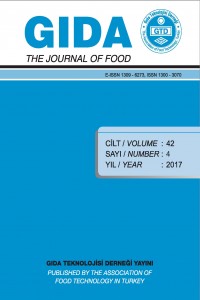Öz
Karboksimetil
selüloz (CMC)-guar gam (GG) karışımlarının sünme-geri
dönüş ölçümlerine dayanan Burger model parametreleri farklı gam
konsantrasyonları (%1.5, 2.0, 2.5) ve hacimsel gam karışım oranları (25:75, 50:50, 75:25),
farklı sıcaklıklarda (15, 25,
°C
edilmiştir. Dört bileşenli burger model ve deneysel sünme-geri dönüş
özelliklerinden yaralanarak (J0, J1, t1, η0,
Jr0, Jr1 and tr1) gam karışımlarının viskoelastikiyeti karakterize edilmiştir ve gam
karışımlarının sünme-geri dönüş özelliklerinin belirlenmesinde bu model (R2= 0.82-0.99)
tatmin edici bulunmuştur. Özellikle düşük sıcaklıklarda, yüksek GG içeren konsantre
gam karışımları CMC ile karşılaştırıldığı zaman karışımın elastisitesini ve mukavemetini
arttırmıştır. Öte yandan, yüksek sıcaklıkta karışımın viskoz özelliği
baskındır. Burger model regresyon parametrelerinin hacimsel CMC-GG karışım
oranı ve konsantrasyonuna kıyasla daha çok sıcaklığa bağlı olduğu bulunmuştur.
Anahtar Kelimeler
Burger modeli sünme-geri dönüş yanıtları CMC-GG karışım viskoelastikiyet reoloji yanıt yüzey yöntemi
Kaynakça
- Tziboula A, Horne DS. 2000. Gums and Stabilisers for the Food Industry, 2nd ed., RSC: Cambridge.
- Mohsenin NN, Mittal JP. 1977. Use of rheological terms and correlation of compatible measurements in food texture research. J Texture Stud, 8: 395–408.
- Barnes HA, Hutton JF, Walters K. 1989. An Introduction to Rheology. J Non-Newton Fluid Mech, 32: 331-333.
- Ferry JD. 1980. Viscoelastic properties of polymers, 3rd ed., John Wiley: New York.
- Larsen DS, Tang J, Ferguson L, Morgenstern MP, James B. 2015. Textural Complexity is a Food Property – Shown Using Model Foods. Int J Food Prop, 19: 1544-1555.
- Chompoorat P, Ambardekar A, Mulvaney S, Rayas-Duarte P. 2013. Rheological Characteristics of Gluten after Modified by DATEM, Ascorbic Acid, Urea and DTT Using Creep-Recovery Test. J Mod Phys, 4: 1-8.
- Dogan M, Ersoz NB, Toker OS, Kaya Y, Canıyılmaz E. 2014. Optimization of gum combination for instant pudding based on creep and recovery parameters by mixture design approach. Eur Food Res Technol, 238: 47-58.
- Dogan M, Kayacier A, Toker ÖS, Yilmaz MT, Karaman S. 2013. Steady, dynamic, creep, and recovery analysis of ice cream mixes added with different concentrations of xanthan gum. Food Bioprocess Tech, 6: 1420–1433.
- Uzuner S, Tezel GB, Cakmak KN. 2016. Effect of temperature, gum concentration and gum ratio on creep-recovery behaviour of carboxymethyl cellulose-guar gum mixtures: modeling with RSM and ANN. Ital J Food Sci, 28: 273- 288.
- Burgers J. 1939. Mechanical considerations-model systems phenomenological theories of relaxation and of viscosity. First report on viscosity and plasticity, New York, Nordemann.
- Das S, Ghosh A. 2006. Study of creep, stress relaxation, and inverse relaxation in mulberry (Bombyx mori) and tasar (Antheraea mylitta) silk. J Appl Polym Sci, 99: 3077–3084.
- Zahangir AM, Suleyman AM, Rosmaziah W.2008. Statistical optimization of process conditions for cellulase production by liquid state bioconversion of domestic wastewater sludge. Bioresour Technol, 99: 4709-4716.
Öz
Different gum
concentrations of carboxymethyl
cellulose (CMC)-guar gum (GG) mixtures (1.5, 2.0, 2.5%) and their volumetric
mixing ratio (25:75, 50:50, 75:25) were analyzed for Burger model parameters by
using response surface design approach based on creep-recovery
measurements at 15, 25,
of gum mixtures with experimental creep-recovery
responses (J0, J1, t1, η0,
Jr0, Jr1 and tr1)
and it was found
to be satisfactory (R2= 0.82-0.99) for the determination of the creep-recovery properties of gum mixtures. The high ratio of GG in concentrated CMC-GG mixture provided
an increase in the elasticity in the strong or stiffer structure of gum mixtures at
especially low temperatures when it was compared to CMC. However, at high
temperature viscous property of the CMC-GG mixture was dominant. It was found
that regressed parameters from Burger model were highly dependent to temperature
with respect to both volumetric mixing ratio and concentration.
Anahtar Kelimeler
Burger model creep-recovery responses CMC-GG mixture viscoelasticity rheology response surface methodolog
Kaynakça
- Tziboula A, Horne DS. 2000. Gums and Stabilisers for the Food Industry, 2nd ed., RSC: Cambridge.
- Mohsenin NN, Mittal JP. 1977. Use of rheological terms and correlation of compatible measurements in food texture research. J Texture Stud, 8: 395–408.
- Barnes HA, Hutton JF, Walters K. 1989. An Introduction to Rheology. J Non-Newton Fluid Mech, 32: 331-333.
- Ferry JD. 1980. Viscoelastic properties of polymers, 3rd ed., John Wiley: New York.
- Larsen DS, Tang J, Ferguson L, Morgenstern MP, James B. 2015. Textural Complexity is a Food Property – Shown Using Model Foods. Int J Food Prop, 19: 1544-1555.
- Chompoorat P, Ambardekar A, Mulvaney S, Rayas-Duarte P. 2013. Rheological Characteristics of Gluten after Modified by DATEM, Ascorbic Acid, Urea and DTT Using Creep-Recovery Test. J Mod Phys, 4: 1-8.
- Dogan M, Ersoz NB, Toker OS, Kaya Y, Canıyılmaz E. 2014. Optimization of gum combination for instant pudding based on creep and recovery parameters by mixture design approach. Eur Food Res Technol, 238: 47-58.
- Dogan M, Kayacier A, Toker ÖS, Yilmaz MT, Karaman S. 2013. Steady, dynamic, creep, and recovery analysis of ice cream mixes added with different concentrations of xanthan gum. Food Bioprocess Tech, 6: 1420–1433.
- Uzuner S, Tezel GB, Cakmak KN. 2016. Effect of temperature, gum concentration and gum ratio on creep-recovery behaviour of carboxymethyl cellulose-guar gum mixtures: modeling with RSM and ANN. Ital J Food Sci, 28: 273- 288.
- Burgers J. 1939. Mechanical considerations-model systems phenomenological theories of relaxation and of viscosity. First report on viscosity and plasticity, New York, Nordemann.
- Das S, Ghosh A. 2006. Study of creep, stress relaxation, and inverse relaxation in mulberry (Bombyx mori) and tasar (Antheraea mylitta) silk. J Appl Polym Sci, 99: 3077–3084.
- Zahangir AM, Suleyman AM, Rosmaziah W.2008. Statistical optimization of process conditions for cellulase production by liquid state bioconversion of domestic wastewater sludge. Bioresour Technol, 99: 4709-4716.
Ayrıntılar
| Bölüm | Makaleler |
|---|---|
| Yazarlar | |
| Yayımlanma Tarihi | 25 Nisan 2017 |
| Yayımlandığı Sayı | Yıl 2017 Cilt: 42 Sayı: 4 |



